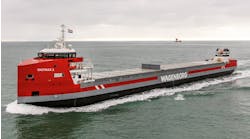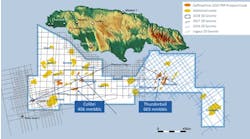Jeremy Beckman • London
Shetland gas corridor expands
DONG Energy has proven gas with its first operated exploration well west of the Shetlands. Preliminary wireline log analysis suggests the well on the Glenlivet prospect in license P1195 intersected a net gas section of 61 m (200 ft) in a Palaeocene reservoir. According to partner Faroe Petroleum, reservoir quality appeared to be strong with high porosity, and probably also high permeability. A gas-water contact was not encountered.
The well was drilled by the semisubTransocean Rather in 1,430 ft (436 m) of water in severe weather. Glenlivet is around 15 km (9.3 mi) from the route of Total’s proposed gas export pipeline to Sullom Voe on Shetland. DONG also is a 20% partner in the Laggan and Tormore fields which would provide the initial supplies. Recently, Total acquired an operating stake in the ultra deepwater 1999 Tobermory gas discovery, 175 km (109 mi) northwest of the Shetlands, and declared that this field, too, could figure in the new scheme.
Faroe points out that the P1195 license also contains the undeveloped Laxford gas field and various other exploration candidates close to Glenlivet. Late last month, the company was due to participate in another wildcat in this region on the Tornado oil prospect, close to BP’s producing Schiehallion oil field.
Closer to Shetland, BP has contracted RDS to design drilling facilities for Clair Ridge, a proposed second-phase development of the Clair field targeting the elongated up-thrown part of the field to the north of the Phase 1 complex. BP plans up to 28 wells, with a subsea template for pre-drilled wells tied back to a platform.
Norway struggles to replace reserves
Exploration activity on the Norwegian shelf has been unprecedented over the past couple of years, according to the Norwegian Petroleum Directorate’s latest Resource Report. However, reserves growth in this period has been modest.
In 2005, NPD set a goal of increasing oil reserves on the shelf by 800 MMcm (around 5 Bbbl) by 2015. Yet, latest projections suggest this target may not be reached, despite the high strike rate this year in the North Sea and Norwegian Sea.
Most of the successes have been near-platform wells targeting small, easily accessible accumulations. But these have been offset by disappointments such as Total’s recent appraisal of the Victoria HP/HT gas field, 22 km (13.7 mi) northwest of Heidrun in license PL 211 B in a water depth of 416 m (1,365 ft).
Victoria, discovered in 2000, was thought to be the country’s largest undeveloped gas find, holding potentially 89 bcm (3.1 tcf) recoverable. The latest well, however, drilled by the semisubWest Phoenix, put likely reserves in the range 20-60 bcm (706 bcf-2.1 tcf), based on a more comprehensive test program undertaken amid severe reservoir conditions.
NPD assumes that around 75% of Norway’s reserves growth will come from fields already in production. Recovery methods are improving, notably gas injection, which NPD estimates has so far delivered around 260 MMcm (1.6 Bbbl) of extra oil. Newly emerging technologies could lift recovery further, but qualification and testing of these techniques on fields offshore will require extensive cooperation between oil companies and the Norwegian authorities.
In Norway’s sector of the Barents Sea, NPD has reduced its assessment of recoverable resources from 1,030 MMcmoe to 910 MMcmoe (6.5 Bboe to 5.7 Bboe), despite increased volumes of in-place oil and gas. This is due to a combination of poorer than expected reservoir properties, distance to the market, and the high costs associated with certain development solutions.
Majors commit to mature fields
At the Offshore Europe conference in Aberdeen last month, Total’s Chief Executive Officer Christophe de Margerie warned that high petroleum taxes and service costs could lessen the majors’ commitment to the UK shelf. In the short term, however, it appears to be business as usual.
During the event, ExxonMobil announced plans for a $200-million program to drill three new wells from the Beryl A platform to offset declining production. The Beryl area fields cumulatively have produced 1 Bbbl of oil and condensate since coming on stream in 1976.
Earlier, BP and BG Group concluded an asset swap, under which BG took BP’s equity in and operatorship of Everest and Lomond fields in the central North Sea. In exchange, BG transferred all its E&P interests in the southern gas basin to BP, including the five BG-operated Easington Catchment Area fields.
Mark Carne, BG’s managing director, Europe and Central Asia, said that although the UK central sector is a mature basin, “it is still a highly promising area and we remain one of the most active players. This agreement…will allow the production efficiency of mature fields to be increased and smaller fields to be developed more efficiently.”
Nexen, one of the sector’s stronger independents, also has re-affirmed its commitment. The Canadian company recently brought the Ettrick field on stream in blocks 20/2a and 20/3a via theAoka Mizu FPSO. Its next development could take in a cluster of discoveries in the central sector, collectively known as the Golden Eagle Area. Nexen estimates the gross contingent recoverable resource at 150-275 MMboe, making this the UK’s largest oil and gas find of the past decade after Buzzard, the company claims.
Dutch milestone for Cirrus
Gas has started flowing from the M7-A field, Cirrus Energy’s first operated development project in the Dutch North Sea. Following clean-up operations, the M7-A01X well, drilled by the jackupNoble Lynda Bossler, produced at a maximum rate of 43.1 MMcf/d at a wellhead pressure of 261 bar (3,786 psig) through a 48/64-in. choke. The quality of the primary Triassic sandstone reservoir was higher than the original 1996 discovery well, Cirrus added.
The well is tied into the newly commissioned M7-A monotower in a water depth of 30 m (98.4 ft). The platform, which can accommodate three wells, is linked to third party processing and export infrastructure via a 13-km (8.1-mi), 6-in. (15.24-cm) pipeline.
Aker, Det norske join forces
The boards of Aker Exploration and Det norske oljeselskap have agreed to merge, creating the second largest oil company on the Norwegian shelf, with interests in 70 offshore licenses, 32 of them operated.
The new entity will retain the name Det norske oljeselskap.




